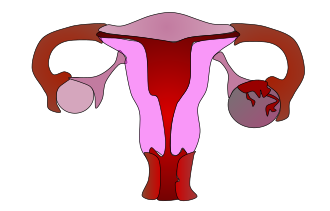Ovarian apoplexy
A medical condition involving the rupture of an ovarian follicle or corpus luteum.
Ovarian Apoplexy
Ovarian apoplexy, also known as ovarian hemorrhage, is a medical condition characterized by the rupture of an ovarian follicle or corpus luteum, leading to bleeding within the ovary. This condition can cause sudden abdominal pain and may require surgical intervention if the bleeding is severe.
Pathophysiology
Ovarian apoplexy occurs when there is a rupture of an ovarian structure, such as a follicle or corpus luteum, during the menstrual cycle. This rupture can lead to bleeding into the ovarian stroma and potentially into the peritoneal cavity. The bleeding can cause irritation of the peritoneum, leading to acute abdominal pain.
Clinical Presentation
Patients with ovarian apoplexy typically present with sudden onset of unilateral lower abdominal pain. The pain may be associated with nausea, vomiting, and sometimes syncope if the bleeding is significant. On physical examination, there may be tenderness in the lower abdomen, and in severe cases, signs of hypovolemic shock may be present.
Diagnosis
The diagnosis of ovarian apoplexy is primarily clinical, supported by imaging studies. Ultrasound is the preferred imaging modality and may show free fluid in the pelvis or an enlarged ovary. Doppler ultrasound can be used to assess blood flow and help differentiate from other causes of acute abdominal pain.
Treatment
The management of ovarian apoplexy depends on the severity of the bleeding and the patient's hemodynamic stability. In mild cases, conservative management with analgesics and observation may be sufficient. In cases of significant hemorrhage, surgical intervention, such as laparoscopy or laparotomy, may be necessary to control the bleeding and repair the ovary.
Prognosis
The prognosis for ovarian apoplexy is generally good, especially with prompt diagnosis and appropriate management. Most women recover fully without long-term complications. However, recurrent episodes can occur, and in rare cases, fertility may be affected if there is significant damage to the ovarian tissue.
Related Pages
Transform your life with W8MD's budget GLP-1 injections from $125.
W8MD offers a medical weight loss program to lose weight in Philadelphia. Our physician-supervised medical weight loss provides:
- Most insurances accepted or discounted self-pay rates. We will obtain insurance prior authorizations if needed.
- Generic GLP1 weight loss injections from $125 for the starting dose.
- Also offer prescription weight loss medications including Phentermine, Qsymia, Diethylpropion, Contrave etc.
NYC weight loss doctor appointments
Start your NYC weight loss journey today at our NYC medical weight loss and Philadelphia medical weight loss clinics.
- Call 718-946-5500 to lose weight in NYC or for medical weight loss in Philadelphia 215-676-2334.
- Tags:NYC medical weight loss, Philadelphia lose weight Zepbound NYC, Budget GLP1 weight loss injections, Wegovy Philadelphia, Wegovy NYC, Philadelphia medical weight loss, Brookly weight loss and Wegovy NYC
|
WikiMD's Wellness Encyclopedia |
| Let Food Be Thy Medicine Medicine Thy Food - Hippocrates |
Medical Disclaimer: WikiMD is not a substitute for professional medical advice. The information on WikiMD is provided as an information resource only, may be incorrect, outdated or misleading, and is not to be used or relied on for any diagnostic or treatment purposes. Please consult your health care provider before making any healthcare decisions or for guidance about a specific medical condition. WikiMD expressly disclaims responsibility, and shall have no liability, for any damages, loss, injury, or liability whatsoever suffered as a result of your reliance on the information contained in this site. By visiting this site you agree to the foregoing terms and conditions, which may from time to time be changed or supplemented by WikiMD. If you do not agree to the foregoing terms and conditions, you should not enter or use this site. See full disclaimer.
Credits:Most images are courtesy of Wikimedia commons, and templates, categories Wikipedia, licensed under CC BY SA or similar.
Contributors: Prab R. Tumpati, MD

